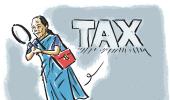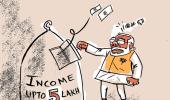'The assumed linear correlation between forced lower yields, higher bank borrowing from the RBI, higher lending, and higher growth involves leaps of faith, each a step on the quicksand of false beliefs,' warns Debashis Basu.

When economic growth falls, the customary expectation is that the Reserve Bank of India would cut interest rates.
And indeed, all mainstream economists, especially those working directly and indirectly in the financial markets, have been ranting that interest rates are too high (set against benign inflation).
Poor growth is seen as a direct consequence of slow lending; banks have been parking their surplus funds with the RBI instead of lending and so credit growth has gone down to 7 per cent.
Only if the RBI cuts rates would the banks be enthused to lend and the economy would boom - so goes this fallacious but simplistic and widely-believed theory.
But the RBI did not cut rates at its February 5 meeting, perhaps because it heeded the concerns of the monetary policy committee that lowering interest rates may push up inflation.
(This is also an untested theory, because a lot of inflation is imported and a lot of domestic inflation is uncorrelated to interest rates; but then, this is the conventional wisdom.)
So, instead of cutting rates, the RBI pulled out a new tool from its kit to deliver the same effect as a rate cut.
That tool is long-term repo operations, LTROs.
Under LTROs, the RBI will lend up to Rs 1 trillion to banks for one and three-year periods at its policy repo rate of 5.15 per cent.
In another move to make banks lend more, the RBI has said that till July 31, 2020, they don't need to maintain a cash reserve ratio for the money they lend for purchasing automobiles and residential housing, and loans to small businesses.
If banks don't need to maintain reserves on deposits used to give certain kinds of loans, for the next few months they will have more money to lend.
What would these two moves achieve?
Four false beliefs
As the saying goes, you can take a horse to water but cannot make it drink.
However, policymakers think they can somehow make the economic horse drink their magic brew and it would start galloping.
The fact is, unless economic actors see a risk-reward ratio in their favour, they won't act.
And if a large number of those actors are government organisations, including lenders, they may not act even if the risk-reward ratio is favourable to them.
The answer, of course, is to change that ratio.
But that is a difficult and longer-term route to growth.
And so, policymakers -- netas and babus (who create more risks than rewards for businesses in the first place) -- search for a quick fix for the symptoms (low lending and low growth), not the disease.
What is the assumption behind the quick-fix called LTROs?
Since the high cost of funds is holding up lending, if the RBI forcibly reduces bond yields, banks will borrow cheap under LTROs and lend more.
More credit from banks will, in turn, push up economic growth.
That assumed linear correlation between forced lower yields, higher bank borrowing from the RBI, higher lending, and higher growth involves leaps of faith, each a step on the quicksand of false beliefs.
First, there are many more factors to economic growth than just increase in credit.
They include strong demand and higher business confidence. Both are missing now.
Second, credit growth is low for many reasons, not merely high yields or high interest rates.
The reasons include high risk/friction in doing business in India and possibly the harassment attached to routine lending decisions of public-sector bankers.
Third, a lower bond yield will not make a material difference to bank lending rates because they want to hold on to any savings they can make on the liabilities side.
Fourth, none of this will significantly reduce the effective cost to the borrowers, especially retail borrowers.
The waiver of the CRR is totally trivial.
Even if interest rates dip by 50 basis points, the equated monthly instalment (EMI) on a car or a house will be a few hundred rupees less.
Is that an incentive enough to buy cars and houses?
People will buy cars or houses when they feel confident of paying the whole EMI; not saving a few hundred rupees.
But that confidence is missing and cannot come from the central bank's tinkering.
Where will LTRO money end up?
This does not mean the RBI's action will have no impact.
We already have a playbook of the impact of such unconventional moves by central banks.
The US federal reserve and the European Central Bank have tried these tools and we know their consequences.
One, banks will park the money borrowed cheap from the RBI in government bonds.
This will lower the Centre's cost of borrowing, easing pressure on the fiscal deficit.
Two, a lot of money will go into corporate bonds, which may boost some lending.
Three, and most importantly, the shortest distance that cheap money travels, through a path of least resistance, is always into speculative assets such as stocks.
Four, as the RBI stands committed to lower yields, fixed deposit rates will drop, putting pressure on hundreds of million savers who live off bank and bond interest.
The effect of this will be two-fold.
First, many savers will move from lower-yielding fixed deposits to mutual funds and stocks, accelerating the trend described in point three, above.
Secondly, those who cannot do this will cut down on consumption, in response to lower interest income.
In short, the RBI has just boosted the value of speculative, not productive, assets and curbed consumption by lowering interest income.
I am not sure these are the consequences the RBI intended to engineer.
Debashis Basu is the editor of www.moneylife.in












 © 2025
© 2025